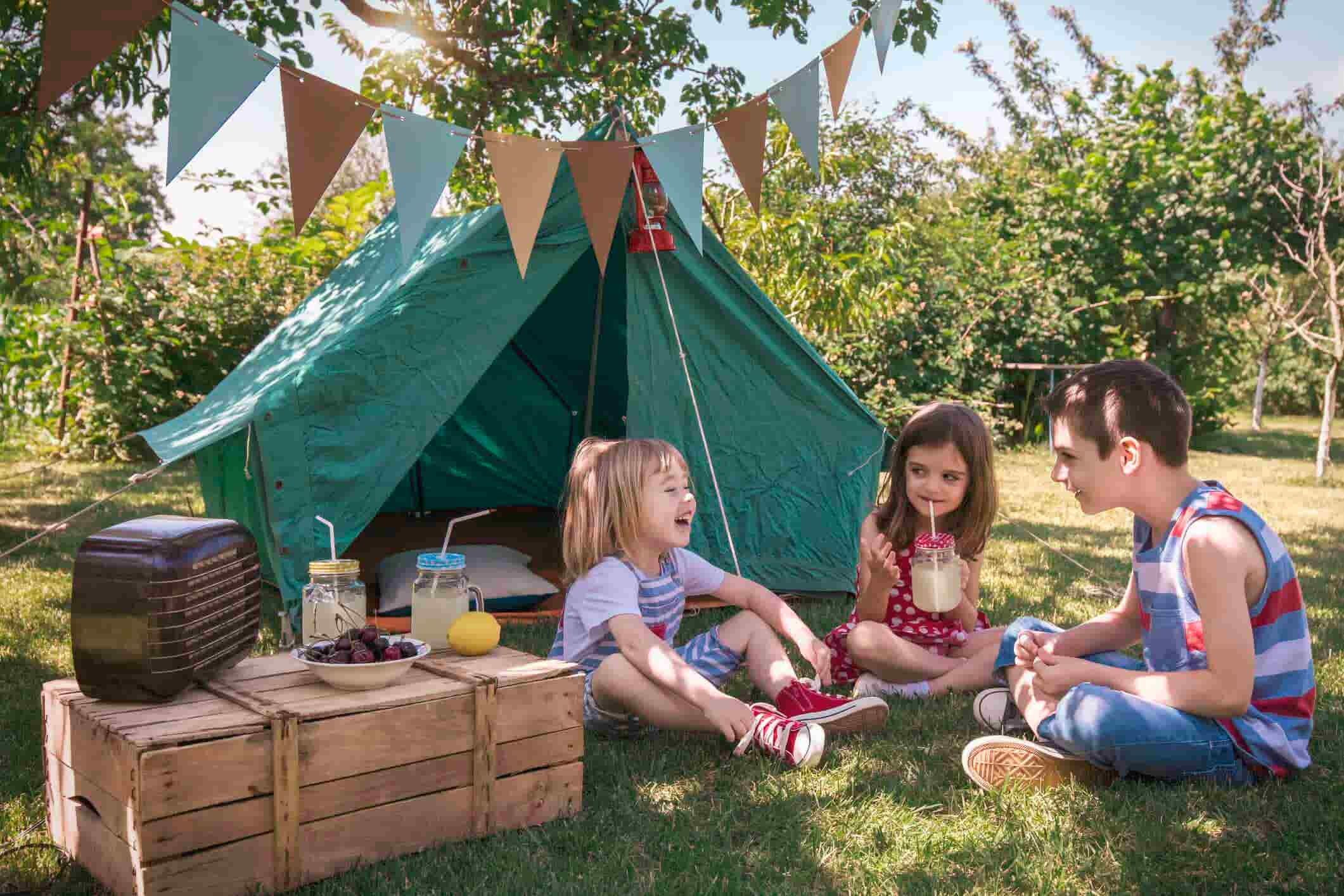Eight fun STEM activities for all the family this Mother's Day
- Laura Hutchinson Posted On Feb 28, 2018 | National Holidays
Are you looking for something fun to do with the kids this Mother’s Day? Keep brains ticking and the whole family engaged with our selection of STEM (science, technology, engineering and maths) activities. There’s something for everyone, indoor and out!Dye your own flowers This simple and stunning experiment is a great way to introduce preschoolers to scientific investigations and natural science. Not only does it give children the opportunity to learn how water transfers through a plant, but the end result will make a great present for Mummy on Mother’s Day too! You’ll need some white flowers (when in season, daisies from the garden will work), glasses of water, a selection of food dye and a sharp knife. Visit redtri.com for more details! Build the world, one landmark at a time
This simple and stunning experiment is a great way to introduce preschoolers to scientific investigations and natural science. Not only does it give children the opportunity to learn how water transfers through a plant, but the end result will make a great present for Mummy on Mother’s Day too! You’ll need some white flowers (when in season, daisies from the garden will work), glasses of water, a selection of food dye and a sharp knife. Visit redtri.com for more details! Build the world, one landmark at a time Create your very own versions of the world’s most famous landmarks — start by either creating landmarks from one city, or pick your favourite landmarks from around the world.Building blocks are perfect for this, or if you want something more tactile, you can always create models out of salt dough instead. It’s cheap, quick and easy to make. All you need is 1 cup of salt, 2 cups of flour and ¾ cup of water. Combine the dry ingredients first before gradually adding the water. Once you’ve sculpted your creations, place them in an oven at 180°C to dry them out. They’ll make great handmade Mother’s Day presents too! Foamy fun chemical reactions
Create your very own versions of the world’s most famous landmarks — start by either creating landmarks from one city, or pick your favourite landmarks from around the world.Building blocks are perfect for this, or if you want something more tactile, you can always create models out of salt dough instead. It’s cheap, quick and easy to make. All you need is 1 cup of salt, 2 cups of flour and ¾ cup of water. Combine the dry ingredients first before gradually adding the water. Once you’ve sculpted your creations, place them in an oven at 180°C to dry them out. They’ll make great handmade Mother’s Day presents too! Foamy fun chemical reactions What happens when you mix red cabbage, baking powder and vinegar?Introduce little ones to chemistry with this straightforward but visually impressive experiment sciencekiddo.com. You may need to start this activity a day early as you need to make some homemade pH indicator ice cubes first. Then you can create a fun and fizzy chemical reaction and discover the PH balance of the solution.It’s easy to get started, you just need a few common kitchen items: red cabbage, water, baking soda, an ice cube tray, large clear cups and vinegar. Hugs o’clock
What happens when you mix red cabbage, baking powder and vinegar?Introduce little ones to chemistry with this straightforward but visually impressive experiment sciencekiddo.com. You may need to start this activity a day early as you need to make some homemade pH indicator ice cubes first. Then you can create a fun and fizzy chemical reaction and discover the PH balance of the solution.It’s easy to get started, you just need a few common kitchen items: red cabbage, water, baking soda, an ice cube tray, large clear cups and vinegar. Hugs o’clock We don’t need an excuse to give Mum, or Grandma, a hug. That being said, it’s Mother’s Day, so extra hugs are always appreciated. A great task to set the kids is to hug Mum or Grandma at pre set times throughout the day. The first one will be a nice surprise for her, but it will also teach little ones about telling the time! Nature-themed scavenger hunt
We don’t need an excuse to give Mum, or Grandma, a hug. That being said, it’s Mother’s Day, so extra hugs are always appreciated. A great task to set the kids is to hug Mum or Grandma at pre set times throughout the day. The first one will be a nice surprise for her, but it will also teach little ones about telling the time! Nature-themed scavenger hunt To blow out the cobwebs and get some fresh air, head outdoors for a nature-themed scavenger hunt! Set to work creating clues and setting tasks for the kids to complete. Challenges could include snapping photos of particular plants or wildlife. All you need is a camera, phone or tablet. Alternatively, go freestyle and take notes about all of the flora and fauna you see on your adventures. Flower number fun
To blow out the cobwebs and get some fresh air, head outdoors for a nature-themed scavenger hunt! Set to work creating clues and setting tasks for the kids to complete. Challenges could include snapping photos of particular plants or wildlife. All you need is a camera, phone or tablet. Alternatively, go freestyle and take notes about all of the flora and fauna you see on your adventures. Flower number fun Image source: multiculturalmotherhood.comDraw and cut out your own flowers with two sets of 12 petals each. Then number the inner ring of petals one to 12. Pick a number for the centre of the flower and choose whether you add or multiply the central number by the number of the petal. Got the answer? Write it on the connected outer petal. This is a fun way of bringing the worlds of mathematics and art together. Creative in the kitchen
Image source: multiculturalmotherhood.comDraw and cut out your own flowers with two sets of 12 petals each. Then number the inner ring of petals one to 12. Pick a number for the centre of the flower and choose whether you add or multiply the central number by the number of the petal. Got the answer? Write it on the connected outer petal. This is a fun way of bringing the worlds of mathematics and art together. Creative in the kitchen Mums love to be treated, and what’s better than homemade goodies prepared by little hands? Cooking also brings a wealth of learning opportunities. Measuring ingredients will help improve children’s maths skills, while following instructions and learning about safe food preparation are important life lessons. The best part though is that the whole family can enjoy the results! Bake cakes, biscuits or savoury snacks. Family fort buildingBuilding forts together is not just good fun, it also stimulates early engineering skills. While planning and building your perfect hide-away together your little one will learn about design and problem-solving. Is your structure collapsing due to lack of support? Does it need a stronger material to stand up? Can a triangular structure bear more weight than a square one? All of these questions lay the foundations for budding engineers.Share your storiesWe hope that our fun-filled STEM activities have inspired you to try something new together this Mother’s Day. Share you favourite crafts and creations with us on Instagram @learningresourcesuk
Mums love to be treated, and what’s better than homemade goodies prepared by little hands? Cooking also brings a wealth of learning opportunities. Measuring ingredients will help improve children’s maths skills, while following instructions and learning about safe food preparation are important life lessons. The best part though is that the whole family can enjoy the results! Bake cakes, biscuits or savoury snacks. Family fort buildingBuilding forts together is not just good fun, it also stimulates early engineering skills. While planning and building your perfect hide-away together your little one will learn about design and problem-solving. Is your structure collapsing due to lack of support? Does it need a stronger material to stand up? Can a triangular structure bear more weight than a square one? All of these questions lay the foundations for budding engineers.Share your storiesWe hope that our fun-filled STEM activities have inspired you to try something new together this Mother’s Day. Share you favourite crafts and creations with us on Instagram @learningresourcesuk
 This simple and stunning experiment is a great way to introduce preschoolers to scientific investigations and natural science. Not only does it give children the opportunity to learn how water transfers through a plant, but the end result will make a great present for Mummy on Mother’s Day too! You’ll need some white flowers (when in season, daisies from the garden will work), glasses of water, a selection of food dye and a sharp knife. Visit redtri.com for more details! Build the world, one landmark at a time
This simple and stunning experiment is a great way to introduce preschoolers to scientific investigations and natural science. Not only does it give children the opportunity to learn how water transfers through a plant, but the end result will make a great present for Mummy on Mother’s Day too! You’ll need some white flowers (when in season, daisies from the garden will work), glasses of water, a selection of food dye and a sharp knife. Visit redtri.com for more details! Build the world, one landmark at a time Create your very own versions of the world’s most famous landmarks — start by either creating landmarks from one city, or pick your favourite landmarks from around the world.Building blocks are perfect for this, or if you want something more tactile, you can always create models out of salt dough instead. It’s cheap, quick and easy to make. All you need is 1 cup of salt, 2 cups of flour and ¾ cup of water. Combine the dry ingredients first before gradually adding the water. Once you’ve sculpted your creations, place them in an oven at 180°C to dry them out. They’ll make great handmade Mother’s Day presents too! Foamy fun chemical reactions
Create your very own versions of the world’s most famous landmarks — start by either creating landmarks from one city, or pick your favourite landmarks from around the world.Building blocks are perfect for this, or if you want something more tactile, you can always create models out of salt dough instead. It’s cheap, quick and easy to make. All you need is 1 cup of salt, 2 cups of flour and ¾ cup of water. Combine the dry ingredients first before gradually adding the water. Once you’ve sculpted your creations, place them in an oven at 180°C to dry them out. They’ll make great handmade Mother’s Day presents too! Foamy fun chemical reactions What happens when you mix red cabbage, baking powder and vinegar?Introduce little ones to chemistry with this straightforward but visually impressive experiment sciencekiddo.com. You may need to start this activity a day early as you need to make some homemade pH indicator ice cubes first. Then you can create a fun and fizzy chemical reaction and discover the PH balance of the solution.It’s easy to get started, you just need a few common kitchen items: red cabbage, water, baking soda, an ice cube tray, large clear cups and vinegar. Hugs o’clock
What happens when you mix red cabbage, baking powder and vinegar?Introduce little ones to chemistry with this straightforward but visually impressive experiment sciencekiddo.com. You may need to start this activity a day early as you need to make some homemade pH indicator ice cubes first. Then you can create a fun and fizzy chemical reaction and discover the PH balance of the solution.It’s easy to get started, you just need a few common kitchen items: red cabbage, water, baking soda, an ice cube tray, large clear cups and vinegar. Hugs o’clock We don’t need an excuse to give Mum, or Grandma, a hug. That being said, it’s Mother’s Day, so extra hugs are always appreciated. A great task to set the kids is to hug Mum or Grandma at pre set times throughout the day. The first one will be a nice surprise for her, but it will also teach little ones about telling the time! Nature-themed scavenger hunt
We don’t need an excuse to give Mum, or Grandma, a hug. That being said, it’s Mother’s Day, so extra hugs are always appreciated. A great task to set the kids is to hug Mum or Grandma at pre set times throughout the day. The first one will be a nice surprise for her, but it will also teach little ones about telling the time! Nature-themed scavenger hunt To blow out the cobwebs and get some fresh air, head outdoors for a nature-themed scavenger hunt! Set to work creating clues and setting tasks for the kids to complete. Challenges could include snapping photos of particular plants or wildlife. All you need is a camera, phone or tablet. Alternatively, go freestyle and take notes about all of the flora and fauna you see on your adventures. Flower number fun
To blow out the cobwebs and get some fresh air, head outdoors for a nature-themed scavenger hunt! Set to work creating clues and setting tasks for the kids to complete. Challenges could include snapping photos of particular plants or wildlife. All you need is a camera, phone or tablet. Alternatively, go freestyle and take notes about all of the flora and fauna you see on your adventures. Flower number fun Image source: multiculturalmotherhood.comDraw and cut out your own flowers with two sets of 12 petals each. Then number the inner ring of petals one to 12. Pick a number for the centre of the flower and choose whether you add or multiply the central number by the number of the petal. Got the answer? Write it on the connected outer petal. This is a fun way of bringing the worlds of mathematics and art together. Creative in the kitchen
Image source: multiculturalmotherhood.comDraw and cut out your own flowers with two sets of 12 petals each. Then number the inner ring of petals one to 12. Pick a number for the centre of the flower and choose whether you add or multiply the central number by the number of the petal. Got the answer? Write it on the connected outer petal. This is a fun way of bringing the worlds of mathematics and art together. Creative in the kitchen Mums love to be treated, and what’s better than homemade goodies prepared by little hands? Cooking also brings a wealth of learning opportunities. Measuring ingredients will help improve children’s maths skills, while following instructions and learning about safe food preparation are important life lessons. The best part though is that the whole family can enjoy the results! Bake cakes, biscuits or savoury snacks. Family fort buildingBuilding forts together is not just good fun, it also stimulates early engineering skills. While planning and building your perfect hide-away together your little one will learn about design and problem-solving. Is your structure collapsing due to lack of support? Does it need a stronger material to stand up? Can a triangular structure bear more weight than a square one? All of these questions lay the foundations for budding engineers.Share your storiesWe hope that our fun-filled STEM activities have inspired you to try something new together this Mother’s Day. Share you favourite crafts and creations with us on Instagram @learningresourcesuk
Mums love to be treated, and what’s better than homemade goodies prepared by little hands? Cooking also brings a wealth of learning opportunities. Measuring ingredients will help improve children’s maths skills, while following instructions and learning about safe food preparation are important life lessons. The best part though is that the whole family can enjoy the results! Bake cakes, biscuits or savoury snacks. Family fort buildingBuilding forts together is not just good fun, it also stimulates early engineering skills. While planning and building your perfect hide-away together your little one will learn about design and problem-solving. Is your structure collapsing due to lack of support? Does it need a stronger material to stand up? Can a triangular structure bear more weight than a square one? All of these questions lay the foundations for budding engineers.Share your storiesWe hope that our fun-filled STEM activities have inspired you to try something new together this Mother’s Day. Share you favourite crafts and creations with us on Instagram @learningresourcesuk 










 Fresh Veggies Day is on the 16th of June and emphasises the importance of eating fresh fruit and vegetables every day.Liz Roffe is our Sales Office Manager and resident vegetable grower! We caught up with her to find out about her vegetable patch and asked for hints, tips and recipe inspiration in celebration of Fresh Veggies Day! Where is your vegetable patch and how long have you had it for?
Fresh Veggies Day is on the 16th of June and emphasises the importance of eating fresh fruit and vegetables every day.Liz Roffe is our Sales Office Manager and resident vegetable grower! We caught up with her to find out about her vegetable patch and asked for hints, tips and recipe inspiration in celebration of Fresh Veggies Day! Where is your vegetable patch and how long have you had it for? Our veggie patch is part of our garden and we have had it since moving in, so around nine years.It’s nice having it as part of the garden as you can just pop out and get fresh veggies for tea each evening (you’ve got to have obligatory veggies for tea in our house!) What vegetables do you grow and which is your favourite?We grow a range of veggies including: carrots, parsnips, sweet corn, butternut squash, brussel sprouts, cauliflower, peas, broad beans, leeks, spinach, potatoes, onions, beetroot, runner beans, French beans & broccoli. My favourite is freshly picked sweet corn, you can’t beat it!
Our veggie patch is part of our garden and we have had it since moving in, so around nine years.It’s nice having it as part of the garden as you can just pop out and get fresh veggies for tea each evening (you’ve got to have obligatory veggies for tea in our house!) What vegetables do you grow and which is your favourite?We grow a range of veggies including: carrots, parsnips, sweet corn, butternut squash, brussel sprouts, cauliflower, peas, broad beans, leeks, spinach, potatoes, onions, beetroot, runner beans, French beans & broccoli. My favourite is freshly picked sweet corn, you can’t beat it! (Liz’s sweet corn plants in the greenhouse before being planted)
(Liz’s sweet corn plants in the greenhouse before being planted) (Liz’s sweet corn plants after being planted) What is the easiest vegetable to grow, and which one takes the most effort?I grow most of my plants from seeds in pots before planting them in the patch. Things like carrots, potatoes and parsnips are planted directly. The easiest things to grow are sweet corn and butternut squash as, once planted in the patch, they pretty much look after themselves. Carrots, beetroot and parsnips just need a bit of thinning out and covering but apart from that they are quite easy to look after too.
(Liz’s sweet corn plants after being planted) What is the easiest vegetable to grow, and which one takes the most effort?I grow most of my plants from seeds in pots before planting them in the patch. Things like carrots, potatoes and parsnips are planted directly. The easiest things to grow are sweet corn and butternut squash as, once planted in the patch, they pretty much look after themselves. Carrots, beetroot and parsnips just need a bit of thinning out and covering but apart from that they are quite easy to look after too. How much time goes in to maintaining the patch?Once the veggies are planted it’s just a case of keeping the weeds down and watering them when it’s hot. Initially it can be a little time consuming but just doing the odd 15 minutes here and there is enough to keep on top of things. What are the biggest challenges when growing your own veg?Bugs and slugs! We do our best to use natural remedies and nets to keep them at bay. What time of year do you reap the rewards of your efforts?We try to have things in the garden all year round but there are some times at the beginning of the year when things are a little sparse. It’s normally from July/August onwards when we have an abundance of veggies.
How much time goes in to maintaining the patch?Once the veggies are planted it’s just a case of keeping the weeds down and watering them when it’s hot. Initially it can be a little time consuming but just doing the odd 15 minutes here and there is enough to keep on top of things. What are the biggest challenges when growing your own veg?Bugs and slugs! We do our best to use natural remedies and nets to keep them at bay. What time of year do you reap the rewards of your efforts?We try to have things in the garden all year round but there are some times at the beginning of the year when things are a little sparse. It’s normally from July/August onwards when we have an abundance of veggies. How do you keep the soil rich and nutritious?My husband David and I compost all of the leaves from the garden and use it on the veggie patch. We also add horse manure. Once a year, to help keep the soil light, we add recycled compost from a nursery, normally a tractor trailer load.
How do you keep the soil rich and nutritious?My husband David and I compost all of the leaves from the garden and use it on the veggie patch. We also add horse manure. Once a year, to help keep the soil light, we add recycled compost from a nursery, normally a tractor trailer load. (David ploughing with his Anzani Iron Horse, a piece of horticultural machinery from 1945) What advice would you give to somebody who was thinking about starting a vegetable patch? Do it! Even if you don’t grow things from seeds you can get veggie plants ready to set out from garden centres. However small a patch, there is nothing better that having fresh veggies straight from the garden. Do you have any special recipes you can share with us?As we get quite a lot of butternut squash I make soup which is lovely.
(David ploughing with his Anzani Iron Horse, a piece of horticultural machinery from 1945) What advice would you give to somebody who was thinking about starting a vegetable patch? Do it! Even if you don’t grow things from seeds you can get veggie plants ready to set out from garden centres. However small a patch, there is nothing better that having fresh veggies straight from the garden. Do you have any special recipes you can share with us?As we get quite a lot of butternut squash I make soup which is lovely. *Browse our
*Browse our 








